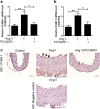Selective inhibition of histone deacetylase 8 improves vascular hypertrophy, relaxation, and inflammation in angiotensin II hypertensive mice
- PMID: 31223486
- PMCID: PMC6570901
- DOI: 10.1186/s40885-019-0118-8
Selective inhibition of histone deacetylase 8 improves vascular hypertrophy, relaxation, and inflammation in angiotensin II hypertensive mice
Abstract
Background: The dysregulation of histone deacetylase (HDAC) protein expression or its enzyme activity is implicated in a variety of diseases. Cardiac HDAC6 and HDAC8 enzyme activity induced by deoxycorticosterone acetate (DOCA) hypertension was attenuated by sodium valproate, a pan-HDAC inhibitor. However, the HDAC6-selective inhibitor, tubastatin A, did not attenuate angiotensin II-induced hypertension. The purpose of this study was to investigate whether PCI34051, an HDAC8-selective inhibitor, can modulate angiotensin II-induced hypertension and its regulatory mechanism.
Methods: An angiotensin II-regulated mouse model was used in this study. Animals received vehicle or PCI34051 (3 mg·kg - 1·day- 1) via intraperitoneal injection. Systolic blood pressure was measured by the tail-cuff method. Blood vessel thickness was measured following hematoxylin and eosin staining, VCAM-1 immunohistochemistry was performed in the aortas, and mRNA expression of renin-angiotensin system components, inflammation markers, and NADPH oxidase (Nox) was determined by RT-PCR. The effect of PCI34051 on vasorelaxation was studied in rat aortic rings, and its effect on nitric oxide (NO) production was determined using DAF-FM DA, a fluorescent dye, in human umbilical vascular endothelial cells (HUVECs).
Results: PCI34051 administration reduced systolic blood pressure via downregulation of angiotensin II receptor type 1 (AT1) mRNA expression. PCI34051 treatment attenuated vascular hypertrophy by decreasing E2F3 and GATA6 mRNA expression. Vascular relaxation after PCI34051 treatment was more dependent on vascular endothelial cells and it was blocked by an NO synthase (NOS) inhibitor. In addition, NO production increased in HUVECs after PCI34051 treatment; this was decreased by the NOS inhibitor. The expression of inflammatory molecules and adhesion molecules VCAM-1 and ICAM-1 decreased in the aortas of angiotensin II-infused mice after PCI34051 administration. However, PCI34051 did not affect Nox or its regulatory subunits.
Conclusions: PCI34051 lowered high blood pressure through modulation of arterial remodeling, vasoconstriction, and inflammation in an angiotensin II-induced hypertension model. We suggest that HDAC8 could be a potential therapeutic target for hypertension.
Keywords: Arterial remodeling; Hypertension; Inflammation; PCI34051; Vascular relaxation.
Conflict of interest statement
Competing interestsThe authors declare that they have no competing interest.
Figures






Similar articles
-
Hdac8 Inhibitor Alleviates Transverse Aortic Constriction-Induced Heart Failure in Mice by Downregulating Ace1.Oxid Med Cell Longev. 2022 Jan 27;2022:6227330. doi: 10.1155/2022/6227330. eCollection 2022. Oxid Med Cell Longev. 2022. PMID: 35126818 Free PMC article.
-
Class I histone deacetylase inhibitor MS-275 attenuates vasoconstriction and inflammation in angiotensin II-induced hypertension.PLoS One. 2019 Mar 4;14(3):e0213186. doi: 10.1371/journal.pone.0213186. eCollection 2019. PLoS One. 2019. PMID: 30830950 Free PMC article.
-
Histone deacetylase inhibitor LMK235 attenuates vascular constriction and aortic remodelling in hypertension.J Cell Mol Med. 2019 Apr;23(4):2801-2812. doi: 10.1111/jcmm.14188. Epub 2019 Feb 7. J Cell Mol Med. 2019. PMID: 30734467 Free PMC article.
-
Selective HDAC8 Inhibition Attenuates Isoproterenol-Induced Cardiac Hypertrophy and Fibrosis via p38 MAPK Pathway.Front Pharmacol. 2021 Apr 20;12:677757. doi: 10.3389/fphar.2021.677757. eCollection 2021. Front Pharmacol. 2021. PMID: 33959033 Free PMC article.
-
Tubastatin A suppresses renal fibrosis via regulation of epigenetic histone modification and Smad3-dependent fibrotic genes.Vascul Pharmacol. 2015 Sep;72:130-40. doi: 10.1016/j.vph.2015.04.006. Epub 2015 Apr 25. Vascul Pharmacol. 2015. PMID: 25921924
Cited by
-
Histone deacetylases: Regulation of vascular homeostasis via endothelial cells and vascular smooth muscle cells and the role in vascular pathogenesis.Genes Dis. 2024 Jan 22;11(6):101216. doi: 10.1016/j.gendis.2024.101216. eCollection 2024 Nov. Genes Dis. 2024. PMID: 39281836 Free PMC article. Review.
-
Blocking VCAM-1 Prevents Angiotensin II-Induced Hypertension and Vascular Remodeling in Mice.Front Pharmacol. 2022 Feb 10;13:825459. doi: 10.3389/fphar.2022.825459. eCollection 2022. Front Pharmacol. 2022. PMID: 35222039 Free PMC article.
-
Roles of Epigenetics in Cardiac Fibroblast Activation and Fibrosis.Cells. 2022 Jul 30;11(15):2347. doi: 10.3390/cells11152347. Cells. 2022. PMID: 35954191 Free PMC article. Review.
-
Histone Deacetylase (HDAC) Inhibitors for the Treatment of Schistosomiasis.Pharmaceuticals (Basel). 2022 Jan 10;15(1):80. doi: 10.3390/ph15010080. Pharmaceuticals (Basel). 2022. PMID: 35056137 Free PMC article. Review.
-
Hdac8 Inhibitor Alleviates Transverse Aortic Constriction-Induced Heart Failure in Mice by Downregulating Ace1.Oxid Med Cell Longev. 2022 Jan 27;2022:6227330. doi: 10.1155/2022/6227330. eCollection 2022. Oxid Med Cell Longev. 2022. PMID: 35126818 Free PMC article.
References
-
- Savoia C, Schiffrin EL. Inflammation in hypertension. Curr Opin Nephrol Hypertens. 2006;15:152–158. - PubMed
LinkOut - more resources
Full Text Sources
Other Literature Sources
Research Materials
Miscellaneous
